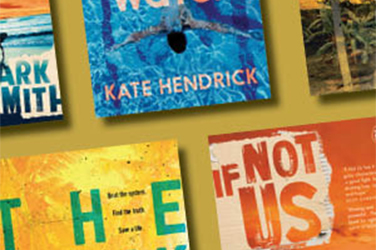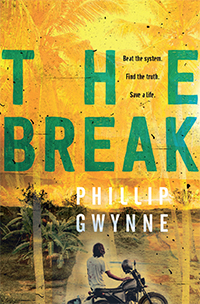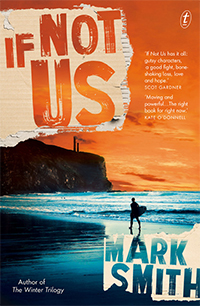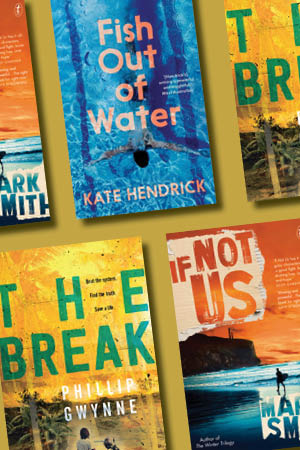- Free Article: No
- Contents Category: Young Adult Fiction
- Custom Article Title: Three new Young Adult novels
- Review Article: Yes
- Article Title: Sinister undercurrents
- Article Subtitle: Three new Young Adult novels
- Online Only: No
- Custom Highlight Text:
Few traits typify the mythology of the Aussie bloke quite as strongly as a love of water and a laid-back attitude. Increasingly acknowledged is the role violence plays in shaping our laconic beach-lovers. Three Young Adult novels tackle this sinister undercurrent of male identity, but in different ways and to different effects. In Kate Hendrick’s Fish Out of Water (Text Publishing, $19.99 pb, 288 pp), swimmer Finn aspires to be a ‘top bloke’ like his father, but does he really? Philip Gwynne’s Taj just wants to surf, but he must deal with a foreign government intent on executing his father in The Break (Penguin Books, $19.99 pb, 384 pp). In If Not Us (Text Publishing, $19.99 pb, 272 pp), by Mark Smith, surfer Hesse is trying to save the environment but soon discovers that taking a public stand on a controversial issue can have dangerous consequences.
- Featured Image (400px * 250px):

- Alt Tag (Featured Image): Ben Chandler reviews 'Fish Out of Water' by Kate Hendrick, 'The Break' by Philip Gwynne, and 'If Not Us' by Mark Smith
Hendrick’s Finn is obsessed with swimming. He keeps his head down, stays in his lane, goes fast, and wins – until the day he doesn’t. Finn’s swimming is the lynchpin of his identity and a tenuous link to his inexplicably absent father. Without swimming, Finn is lost and starts to question everything his father taught him about how to treat other people. Hendrick sets Finn up as the golden boy son of a ‘top bloke’ before slowly chipping away at the foundations of that identity with thriller-like intensity. The spark for Finn’s journey into self-discovery comes from the wonderfully exasperated Aaliyah, a solitary girl at Finn’s school who takes none of his nonsense. Aaliyah is unwilling to let Finn’s unexamined misogyny go by without comment, but is resentful that he has chosen her to be his sounding board and, eventually, his conscience. Finn gaslights his sister, convinces himself his mother had it coming, and selects a girlfriend as if he were shopping for an accessory, but his attempts to first acknowledge and then escape his negative influences make for a compelling read, and the tension between the man Finn is and the man he could become gives the novel its impetus and urgency.
Hendrick captures Finn’s inner voice perfectly as he struggles to reconcile his growing self-awareness with his need to maintain his star-athlete identity. At times horrified by his own thoughts and deeds, he is compelled to play them out. It all works: Finn is a likeable young man beneath his programming, and worth rooting for. Hendrick’s powerful honesty and uncompromising interrogation of Finn’s mental processes culminate in a thoroughly satisfying conclusion that, fittingly, offers no neat solutions.
 The Break by Philip Gwynne
The Break by Philip Gwynne
Penguin Books, $19.99 pb, 384 pp
Gwynne’s Taj has no time for introspection and little self-awareness. He’s an expat Aussie living with his mother in Bali while his father awaits execution for smuggling drugs into the country. All Taj wants to do is surf and hang out with his girlfriend, Inga. Though vaguely aware of his own privilege, Taj is understandably more concerned with his father’s upcoming sentence than with questioning the societal, geopolitical, and ethical complexities of his situation. It is possible this lack of awareness is Gwynne’s point, but if so, its effect is muddied by the offhanded deployment of certain stereotypes, such as the gaggle of flouncing gay fashionistas on page forty-nine, the wealthy white people who are almost all crooks, and the servile non-white characters. While the reader may interrogate these problematic depictions, the text itself never does.
Gwynne bounces his narrative between several perspectives, each serving to highlight elements of Taj’s character or plight rather than offering much insight into the other focal characters. This is particularly egregious in the case of the two female leads, Inga and Kartika, who have lives of their own but are almost entirely subsumed by Taj’s. It is telling that the culmination of Kartika’s otherwise compelling subplot is told mostly from Taj’s viewpoint and serves to tie otherwise disparate threads from his plot line together. Despite this focus on Taj, he is given surprisingly little chance to develop or demonstrate any innate strengths. He often throws money at his problems, comes across solutions by chance, or requires help to get things done. Kartika, quite literally, kicks butt, but this is Taj’s story, and the others are just along for the ride. Speaking of butt-kicking, Gwynne’s writing shines in the action sequences, and there are plenty of those as Taj attempts to help his father to escape from prison. There are many twists and turns, and enough political intrigue to keep you guessing. Everyone has an agenda, and Taj’s inability to judge someone’s character accurately leads to some tense and exciting moments. It all makes for a ripping yarn before the novel pivots from adventure to mystery in the final third. This shift, while leading to some uneven pacing, is a welcome change that allows Gwynne to tie everything up cohesively, though it’s unclear if Taj learns much from his experiences.
 If Not Us by Mark Smith Text
If Not Us by Mark Smith Text
Publishing, $19.99 pb, 272 pp
Smith’s If Not Us depicts one small Australian coastal town divided by the climate change debate. The town is heavily reliant on the nearby coal mine and power station, but when both are about to be sold a small group of locals, led by protagonist Hesse’s mum, see an opportunity to shut them down for good. Hesse loves surfing, though his father died while surfing many years ago; he even works at the local surf shop on the weekends. He’s worried about the impact of climate change on his beloved coast, but is not convinced that he can do anything about it. As his mother’s action group gains momentum for their campaign, Hesse decides to take a public stance, inadvertently becoming their spokesperson, gaining instant notoriety, and more than a few enemies. Mine employees and union officials see him as the face of their job losses. Climate science deniers are vocal about ignoring him. Media personalities just see him as a story. Even Hesse’s friends are upset with him, as several of their parents work for the company that owns the mine. There’s also the sinister Jago, an adult willing to use intimidation and actual violence against teenagers simply because he enjoys it. Hesse navigates these escalating tensions and threatening personalities while falling for exchange student Fenna, and although their budding romance encapsulates Hesse’s transition to adulthood, Fenna is defined by far more than her relationship to Hesse. The same is true of Felicity, the mine manager’s daughter, who challenges Hesse on his assumptions but may not be a villain after all. While the adult characters are often categorised in Manichean terms, Smith’s teenagers have richly complex lives that operate beyond their immediate needs. The only off-note in his characterisation is how unconvincingly uninterested Hesse is in the social media fallout of his actions. This aside, Smith deftly captures the transition from the teen world of wide-eyed optimism and first love to the adult world of concrete responsibilities and severe repercussions.
The development of the young men at the heart of these novels is shaped by the violence they see, experience, and even perpetuate. That violence is intimate and global, inflicted as readily by governments and ideologues as by strangers, neighbours, loved ones, or nature. Dangers and threats permeate everywhere and everything, and affect everyone, in the lives of these young men. These novels explore how their protagonists navigate through, are shaped by, and ultimately reconcile themselves with the violence around them.



Comments powered by CComment